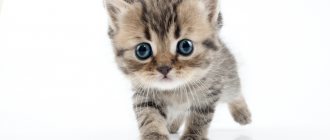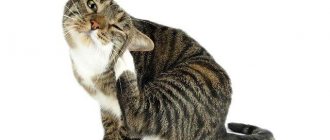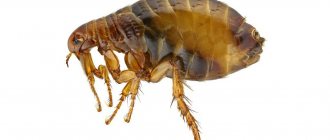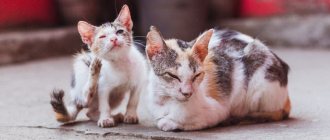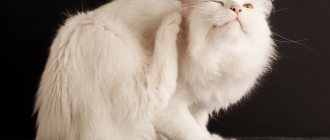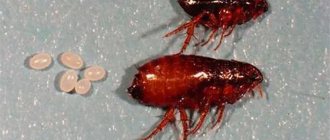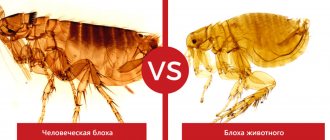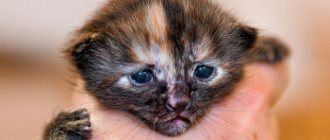The cat is bearing offspring, but she has fleas. An extremely unpleasant situation! The process of removing fleas from a pregnant cat should be approached with the utmost responsibility and caution. The thing is that even means that are absolutely harmless for an adult animal can negatively affect the offspring, complicate the course of pregnancy, and even lead to miscarriages.
The basic rule for flea treatment for a pregnant cat is to prevent the drug from getting ingested. In view of this, the best flea treatments for pregnant cats include:
- gentle shampoos;
- flea collars;
- drops against parasites (strictly with the permission of a veterinarian).
The shampoo and collar do not have a sufficient concentration of the product for it to enter the animal's blood or milk. However, if a cat does not tolerate bathing well, there is no need to expose it to such stress during such an important period of life. When using a flea collar, be sure to remove it afterwards. It is not recommended for a pregnant cat to leave or wear a flea collar as a preventive measure.
Note!
Fleas in a pregnant cat, after the birth of kittens, will almost immediately spread to the babies. Fleas can cause more harm to a small kitten than to an adult animal. For example, they can infect kittens with worms. Cause a number of dermatological diseases that can have fatal consequences for a kitten’s fragile body.
External characteristics of fleas in cats
Most often, when an owner notices blood-sucking parasites on his cat, we are talking about the cat flea, or Ctenocephalides felis.
Despite its name, this type of parasite lives not only on cats, but also on rats and dogs. They can also feed on human blood. In addition to the cat flea, other types of fleas can be found on furry purrs:
- dog;
- rat;
- human;
- rabbit
Their external differences can only be detected under a microscope. Therefore, an ordinary person will not be able to determine with the naked eye which fleas have chosen a pet.
Cat fleas are very small, smooth and look like shiny grain. If they didn't move, it would be very difficult to notice them.
The cat flea can parasitize other animals and also feed on human blood.
A typical cat parasite is approximately 2–3 mm long. The body structure of a flea provides it with the following characteristics:
- The cat flea does not have wings, making it difficult to catch and contain.
- Parasites have a flat body. This ensures ease of movement between the hairs of the victim.
- Elongated hind legs help make large jumps.
- All parasites that attack a cat are dark brown or black in color.
Fleas cause a lot of trouble for both animals and humans.
How to tell if a cat has fleas
Fleas can be detected on an animal’s body based on several signs:
- the cat is acting restless;
- small wounds may appear on the body;
- if you put a cat on a clean sheet of paper and start combing it, tiny black grains will begin to fall out of the fur, which turn blood red when in contact with water;
- Small insects run around the animal's body.
To see flea feces, you need to place the cat on a white towel or paper and start combing it.
The favorite places for fleas on an animal are the chest, back and stomach. And due to the fact that they reproduce at an extremely high rate, their appearance is possible on other parts of the body.
Features of the insect
What are fleas? These are blood-sucking parasites. They are quite unpretentious and tenacious. Squashing a flea is not easy because of its body structure. The parasite has legs designed for jumping long distances. Fleas can go without food and survive for weeks this way. These insects are very prolific, which also poses a serious problem.
What do fleas look like and why are they dangerous?
Fleas have a mouthpart that allows them to bite through the skin of an animal and feed on its blood. Thanks to their laterally flattened body and small, rounded head, insects can move quickly through cat fur. On the surface of the flea's body there are bristly ridges, which also help the parasite cover distances on the animal's body. The flea has six legs, the back two of which are especially well developed. This allows fleas to jump up to half a meter.
These parasites pose a serious danger primarily to kittens, as well as weakened, sick and old animals. Fleas can cause anemia in kittens because one parasite drinks large amounts of blood. In the most advanced cases, fleas can lead to the death of the animal.
In addition to the fact that fleas feed on the blood of animals, they are also carriers of many dangerous diseases. For some types of helminths, fleas are an intermediate host. An animal can accidentally swallow a flea and then the helminth eggs enter the body directly, where they become larvae and then turn into adult parasites.
At the same time, the cat’s skin and fur also suffer greatly. The coat may fall out, lose shine and look unkempt.
Types of fleas in cats
The most common flea that affects cats is C felis, also known as the cat flea. The size of parasites of this species is small - from 2 to 4 mm. They do not have wings, and their small head and laterally flattened body allow them to easily move among the cat’s fur, clinging to the hairs with bristles and spines.
Where do fleas come from?
Fleas are parasites that are active all year round. They live not only on the street, but also in the basements of residential buildings and entrances. You may not even notice the larval eggs hidden in the corners of your apartment: behind baseboards, in cracks, in furniture and folds of linen. The larvae feed on dust and other contaminants, and then, upon reaching sexual maturity, migrate to a pet. Therefore, even a domestic cat can become infected with parasites that you accidentally brought from the street on your clothes or shoes.
Symptoms of flea infestation
You won't be able to avoid noticing fleas on your cat for a long time. The animal quickly begins to show the following signs of the disease:
- An infected cat begins to actively scratch and bite itself, trying to catch parasites.
- The animal is nervous and meows.
- Black crumbs on the skin are parasite excrement and dried blood from scratching bites.
- When examining the cat's back or scruff, you may notice bite marks.
- The presence of fleas themselves on the animal’s fur.
Are fleas the same on dogs and cats?
It happens that dogs and cats suffer from the same type of fleas. Dogs and cats can be parasitized by a specific type of parasite - the cat flea. At the same time, there is also a dog flea, which parasitizes exclusively on dogs.
How often can fleas be poisoned?
The procedure for killing fleas using special drops is carried out once. If necessary, the procedure is repeated after two months. At the same time, the room is treated with special means: the floor, baseboards and the animal’s sleeping area.
Prevention of fleas in kittens of different ages
The best treatment for fleas in a kitten is to prevent their occurrence. Of course, first of all you need to take care of eliminating fleas in the apartment. To do this, the home must be vacuumed daily.
It is important to pay attention to the places where the cat appears most often. It has been noticed that up to 50% of all fleas in the house can be destroyed by this simple hygiene procedure. It is important to protect the kitten from communication with homeless and stray animals
It is important to protect the kitten from communicating with homeless and stray animals. At least once a week you will have to treat the kitten’s sleeping place
The litter can be vacuumed or washed. Don't forget about car and cat carrier treatment
At least once a week you will have to treat the kitten’s sleeping place. The litter can be vacuumed or washed. Don't forget about treating your car and cat carrier.
At the same time, it is necessary to carry out preventive treatment of the animal itself. You can put a collar on it (if age allows) and carefully examine your pet’s skin.
Important: if there is a noticeable deterioration in the kitten’s well-being, you should immediately seek help from a veterinarian. Timely prevention of fleas is the key to a kitten’s activity and curiosity.
Timely prevention of fleas is the key to a kitten’s activity and curiosity.
Little kittens need love and constant care from their owner. It will not be possible to raise a beautiful, devoted and at the same time independent person from a defenseless fluffy ball without effort. Flea control is just one of the problems encountered when caring for a kitten. But your efforts will be rewarded with happy purring and love from your pet.
Galina Shishkina
Pensioner. I live in a village. I love animals, walks in the forest and tinkering in the garden. Cat owners often face the problem of fleas in their pets. These parasites cause a lot of trouble for pets, causing them itching, which occurs after bites. Even a newborn kitten does not escape this fate. Hoping to get rid of insects, small creatures scratch themselves, resulting in scratches and abrasions on their bodies. It is not uncommon for kittens to be allergic to fleas. In addition, cat fleas pose a danger to humans. All this suggests that it is necessary to rid your pet of them. Therefore, the question of how to remove fleas from small kittens interests many owners of these cute creatures.
Newborn pets
The appearance of parasites in such small individuals is associated with a number of consequences. A newborn baby is weak and sensitive to any chemicals. It cannot be sprayed or treated with anything, as the mother cat will lick her cub. The drug passes into breast milk and with it into the stomach of kittens. As a result, the children will receive serious poisoning.
You cannot wash them with shampoo - the cat ensures hygiene for the cubs. It is not recommended to use collars, as they contain essential oils and can cause poisoning and allergic reactions.
It is not possible to remove fleas from a kitten under one month of age. In fact, a mother cat can handle this quite well. She licks the kitten and destroys parasites with her teeth. Therefore, they remain in small quantities and do not pose a danger to the health of babies.
How to remove fleas from a kitten, watch the video yourself:
How to remove fleas from a cat using folk remedies
To rid your pet of biting insects using folk remedies at home, two conditions must be met: a systematic approach and a careful choice of remedy. Only with constant treatment of wool will it be possible to remove parasites and prevent their return
You should pay attention to the components included in the product, some of them may be more toxic than the insecticide
In addition to caring for the cat, it is necessary to treat all cat objects: house, bedding, toys, rug, since they can contain both adults and their offspring. If you ignore this point, you will not be able to remove fleas completely. If there are several cats living in the house, treatment should be carried out simultaneously on all pets, even if only one of them is infected. Treatment with folk remedies demonstrates a high effect with little infection and is used in the following cases:
- cat pregnancy;
- allergic reactions of animals to components of insecticidal agents;
- illness of the animal and the use of traditional household remedies can aggravate the disease;
- presence of a kitten in the house.
Precautions for baiting fleas with insecticides
Any insecticide is, in fact, poison. Accordingly, it is necessary to observe a number of precautions when using them against fleas:
For a kitten
Do not allow toxic compounds to come into contact with your pet’s mucous membranes (nose, eyes, mouth). If the product gets into your eyes, rinse thoroughly. If it is in the nose or mouth, take it to a veterinary facility.
Do not allow the kitten to lick the treated areas.
For the owner
The treatment is carried out using rubber gloves, and if we are talking about a spray, a respirator and goggles to protect the eyes will not be superfluous.
After treatment, the room must be thoroughly ventilated.
While the kitten is being treated, do not allow children or other pets into the room.
If the drug gets into your eyes, rinse it, or on your mucous membranes, call an ambulance.
Review of flea products
Veterinary pharmacies have a large assortment of effective drugs that allow you to remove all kinds of parasites that bother animals. However, many owners of furry creatures are concerned about the question of how to remove fleas from a pregnant cat at home. After all, for such animals it is necessary to select special means that cannot harm either the expectant mother or her offspring. Therefore, ridding the cat of bloodsuckers before the birth of kittens is the main task of every owner of a furry pet. To treat and prevent infection with ectoparasites for pregnant cats, you can use the most gentle and low-toxic means:
It is advisable to discuss the choice of the preferred protective and therapeutic drug or accessory with your veterinarian.
Antiparasitic collars
A special plastic tape impregnated with an insecticidal composition is the most popular and simple means of ridding and protecting an animal from ectoparasites. Many owners are trying to find out whether a pregnant cat can wear a flea collar during the entire period of gestation.
Veterinarians emphasize that in each individual case the question of using a particular drug or flea accessory is decided after examining the animal
Despite this, experts believe that the devices are a safe and effective means of ridding an animal of parasites. This is explained by the fact that medications will not get into the bloodstream or onto the skin of your pet. The most gentle flea treatment for pregnant cats is a biological collar soaked in essential oils that repel bloodsuckers. The most famous representatives of this product line are the Celandine, Doctor Zoo and BioBand straps from the Beaphar, Bars brand. Products marked “bio” contain oils of cinnamon, cloves, bergamot, cedar, lavender and other fragrant plants. Absorbed into the skin and fur, the fragrant composition repels parasites. Despite the complete safety of the impregnation components, you should remember that you should only put a flea collar on a pregnant cat after consulting a doctor.
We were very worried about our cat when they discovered fleas. On the advice of the doctor, I had to put a Celandine bio-collar on her. It’s good that we noticed the insects on time, because after a short period of time there were no parasites on Murka.
Anti-flea shampoos
Specialized pharmacies offer a wide range of insecticidal shampoos that allow you to effectively and safely remove bloodsuckers from your four-legged pets. Detergents are harmless to animals, but dangerous to parasites, as they do not leave them a chance to survive. It is recommended to wash a pregnant cat with flea shampoo only if she is accustomed to bathing and it will not cause her stress.
We saved our pregnant cat from fleas with Lugovoi shampoo. It is safe and contains herbal ingredients. The doctor recommended it. We started bathing our pet a long time ago, so she is not afraid of these procedures. There are no fleas, and future kittens can be safely fed to their mother, without fear that the babies will become infected.
Drop medications
Flea drops for pregnant cats are recommended by a veterinarian after examining her. Poisoning ectoparasites in this way is quite simple - you need to drip medications onto the withers or along the spine of the animal. The best drugs are those that do not penetrate the pet’s blood, act gently and contain low-toxic insecticides in their composition. For animals expecting offspring, veterinarians recommend the safe drugs Frontline, Advantage and Stronghold. They are well tolerated by cats, do not harm kittens and even protect them from parasite infection. It is necessary to apply flea drops onto dry skin, strictly following the instructions. During the procedure, it is recommended to wear gloves to avoid contact with the drug.
Frontline solution saved our cat from fleas. I had to treat it on the advice of a doctor. I recommend it to everyone - simple and safe.
Knowing how and with what to remove dangerous ectoparasites, you can cure a pregnant cat without harming its health.
What is the danger of parasitic insects?
No one is protected from fleas. For an innumerable number of these parasites to appear in your apartment, it is enough to bring in one such bloodsucker. At the same time, it is not at all necessary that the pet come into contact with a flea-bearing animal. A flea can “arrive” on your shoes or on the paws of any pet.
Fleas carry a large number of diseases that pose a threat to both cats and people. We can highlight the main and most common health problems that can arise from these insects:
- Allergic reactions. Some cats are allergic to flea saliva. In this case, the animal will itch even more. And if the allergen is not eliminated in time, then such proximity in some cases leads to hair loss and the formation of scabs on the cat’s body.
- Worms. Fleas carry the eggs of parasites such as pinworms, roundworms, and flukes. While licking its fur, the cat swallows a considerable number of these eggs. And in kittens and weakened animals, helminthic infestation in some cases leads to death.
- Anemia. In advanced situations, long-term coexistence of an animal with fleas leads to anemia in the pet (decreased hemoglobin in the blood).
Human contact with fleas is dangerous because these insects can be carriers of serious diseases. One bite of such parasites can infect a person:
- worms;
- salmonellosis (acute intestinal infection of animals and humans caused by salmonella);
- encephalitis (an inflammatory process affecting the brain);
- typhoid (an infectious disease accompanied by mental disorders against the background of severe fever and intoxication);
- tularemia (an acute infection that affects the lymph nodes, skin, lungs, and sometimes the mucous membranes of the eyes and pharynx);
- brucellosis (a dangerous infection that affects all systems of the body).
One flea bite can lead to many diseases
How does flea infection occur and what is dangerous?
Fleas appear in a lambing cat in the following ways:
- infection occurs during pregnancy;
- parasites are passed on from other pets;
- people bring pests on clothes into the house;
- insects enter the premises from the basement, from the stairwell, from a neighboring infested apartment;
- as a result of re-infection from hatched eggs that were not destroyed during disinsection.
Parasites pose a danger to both mother and cubs:
- After being attacked by blood-sucking insects, kittens experience anemia, stunted growth and delayed weight gain.
- Pests infect kittens with worms and are carriers of dangerous diseases for the cat family: brucellosis, plague, tularemia, typhoid.
- Due to constant itching and burning caused by bites, the cat becomes nervous, irritable, and loses milk.
- Allergic dermatitis appears on the skin of kittens.
- If an animal is allergic to the parasite's saliva, it may cause difficulty breathing, wheezing, and even swelling of the respiratory system, which is deadly for kittens.
Review of flea products
Flea remedies
Veterinary pharmacies have a large assortment of effective drugs that allow you to remove all kinds of parasites that bother animals. However, many owners of furry creatures are concerned about the question of how to remove fleas from a pregnant cat at home. After all, for such animals it is necessary to select special means that cannot harm either the expectant mother or her offspring. Therefore, ridding the cat of bloodsuckers before the birth of kittens is the main task of every owner of a furry pet. To treat and prevent infection with ectoparasites for pregnant cats, you can use the most gentle and low-toxic means:
- flea collars;
- special disinfectant shampoos for cats;
- flea drops
It is advisable to discuss the choice of the preferred protective and therapeutic drug or accessory with your veterinarian.
Antiparasitic collars
A special plastic tape impregnated with an insecticidal composition is the most popular and simple means of ridding and protecting an animal from ectoparasites. Many owners are trying to find out whether a pregnant cat can wear a flea collar during the entire period of gestation.
Veterinarians emphasize that in each individual case the question of using a particular drug or flea accessory is decided after examining the animal
Flea collars
Despite this, experts believe that the devices are a safe and effective means of ridding an animal of parasites. This is explained by the fact that medications will not get into the bloodstream or onto the skin of your pet. The most gentle flea treatment for pregnant cats is a biological collar soaked in essential oils that repel bloodsuckers. The most famous representatives of this product line are the Celandine, Doctor Zoo and BioBand straps from the Beaphar, Bars brand. Products marked “bio” contain oils of cinnamon, cloves, bergamot, cedar, lavender and other fragrant plants. Absorbed into the skin and fur, the fragrant composition repels parasites. Despite the complete safety of the impregnation components, you should remember that you should only put a flea collar on a pregnant cat after consulting a doctor.
Anti-flea shampoos
Specialized pharmacies offer a wide range of insecticidal shampoos that allow you to effectively and safely remove bloodsuckers from your four-legged pets. Detergents are harmless to animals, but dangerous to parasites, as they do not leave them a chance to survive. It is recommended to wash a pregnant cat with flea shampoo only if she is accustomed to bathing and it will not cause her stress.
Lugovoi flea shampoo
Drop medications
Flea drops for pregnant cats are recommended by a veterinarian after examining her. Poisoning ectoparasites in this way is quite simple - you need to drip medications onto the withers or along the spine of the animal. The best drugs are those that do not penetrate the pet’s blood, act gently and contain low-toxic insecticides in their composition. For animals expecting offspring, veterinarians recommend the safe drugs Frontline, Advantage and Stronghold. They are well tolerated by cats, do not harm kittens and even protect them from parasite infection. It is necessary to apply flea drops onto dry skin, strictly following the instructions. During the procedure, it is recommended to wear gloves to avoid contact with the drug.
Knowing how and with what to remove dangerous ectoparasites, you can cure a pregnant cat without harming its health.
Collar
Special repellent collars are saturated with an odor that fleas cannot tolerate, i.e. the product repels (but does not destroy insects). The collar is a porous tape, the material of which retains the smell of the substance applied to it well. This can be either a natural repellent - essential oil, which is safe for cats' health, or a small dose of a synthetic insecticide. For kittens and pregnant cats, collars with natural repellents should be used.
Experts recommend using collars as a preventative measure after the cat’s fleas have already been removed using more powerful insecticidal preparations, or used as a means of complex therapy (i.e. drops + collar). Repellent collars repel not only fleas, but also lice, scabies and ixodid ticks.
The effect of the flea collar lasts up to 8 months. It is very simple to use: just fasten the collar around the cat’s neck and trim off the excess. Do not remove it until the active substance wears off. There is a small “minus”: the fur under the collar cakes, and this is not suitable for cats that take part in exhibitions and competitions.
Collars popular with cat owners: “Bars” (AVZ), “Doctor Zoo”, “Bolfo” (Germany).
If a cat has scratches on its neck, you cannot use a collar; the active substance applied to it can get into the wound and cause a serious allergic reaction in the animal. You can put on a flea collar for cats only after the skin has completely healed.
Treatment of mother cat for fleas
Any antiparasitic treatment of an animal is a burden on the body. Newborn kittens are extremely sensitive to any veterinary flea medications, and most chemicals are prohibited for use until the babies reach a certain age. Failure to comply with this rule can lead to poisoning not only of the babies themselves, but also of their mother. The cat constantly licks its offspring; therefore, everything that is applied to the babies’ fur will end up in its digestive tract, blood and milk. However, you cannot delay treatment, since anemia caused by fleas can claim the lives of all kittens in a matter of days.
The degree of flea infestation can be reduced by treating the cat with veterinary drugs approved for use in lactating animals. Even if a certain number of insects survive, they will not cause much harm to normally developing kittens.
Veterinary drugs approved for use in nursing cats:
- Drops on the withers Advantage (Advantage) 40. A reliable and safe insecticide for external use, which has an “umbrella effect” (when treating a nursing cat, the litter also receives protection). The main active ingredient is imidacloprid. The drug does not affect the central nervous system of mammals. Apply directly to the skin, in a place that the cat cannot lick (between the shoulder blades).
- Frontline Combo drops for cats. A fast-acting remedy with a long-lasting effect. The active ingredients are fipronil and S-methoprene. The drug is safe to use in pregnant and lactating females. Apply to the withers.
- Drops against fleas and ticks Beaphar (Beafar). Natural parasite repellent. The active ingredient is an extract from the Neem (Margosa) tree. Safe drug without side effects.
A nursing cat can be bathed with anti-flea shampoo, but the spray should be used with extreme caution during lactation. Immediately after hair treatment, the cat should not be allowed to lick itself, as some of the toxic substances may enter the digestive tract and milk.
Remedies for getting rid of parasites
The industry produces many effective products that help remove fleas.
Small kittens are very sensitive to various chemicals; treating kittens with flea products should be done carefully and carefully. Their body is not yet ready to take pharmaceuticals, due to the fact that poisoning can occur, not only for them, but also for their mother, since she constantly licks them
The product gets onto the wool, and with it into the milk. Let's look at how to get rid of fleas on a kitten using different types of products:
- Combing with a comb. This method is quite labor-intensive, but if there are one or two kittens in the house, you can use it. You can see what fleas look like on kittens in the photographs in the article. The animal is placed on one's lap, having previously laid down a white diaper or sheet, and is combed with a thick comb in the direction of the baby's fur. You can comb out fleas so easily; they are clearly visible on white fabric. You can't leave them. First, they should be crushed and then placed in a container of water. This method is suitable if the kitten is 2 weeks old or a little more.Getting rid of fleasNote! Insecticides can only be used after the kittens are weaned from the mother's breast. The instructions for any drug contain the required dosage and indication for use. It should be strictly followed.
- Shampoo. Shampoos for kittens are sold in specialized stores. With their help it is easy to get rid of insects. First, apply the shampoo to the entire surface, wait a few minutes, then rinse thoroughly with water. How to use it correctly is written on the tube or bottle. All conditions must be strictly observed. The most popular shampoos are: Lugovoi, Bars, Ms Kiss, Celandine.
- Drops. They are also suitable for removing fleas at home. After making sure that this is a suitable remedy, you need to drip it onto places that cannot be crawled out. The most common place is the area of the withers and shoulder blades. The fleas should die within 24 hours. To consolidate the result, it is recommended to use shampoo after applying the flea drops, remembering to wash the animal’s fur well upon completion of the procedure. The following drops are considered the best: Advantage, Dana Ultra Neo, Frontline. Review
My cat lives in an apartment, so he doesn’t go outside. But the neighbors have a dog, and as a result, my pet picked up fleas from him. I used drops and shampoo to remove it, they helped perfectly.Olga, Kazan
- Flea spray. This is a fairly effective product called Frontline, it is sold in the form of a spray and drops. Spray all over the kitten's fur. The instructions say at what distance this should be done. Many people are interested in the question of how to treat their face so that the spray does not get on the mucous membrane. Cotton swabs are used for this purpose. It is imperative that the drug also gets on the skin, otherwise it will not be possible to remove fleas. Spray and flea collar
- Collar. Some owners believe that this is the best remedy for fleas. It puts on quickly without causing any hassle. This opinion is wrong. It should be put on only after treatment has been completed. The collar is used for preventive purposes; it can protect the kitten from re-infection.
- Mixtures. Special medications are available for sale in veterinary pharmacies. Based on them, solutions are prepared that help get rid of insects. You can treat the fur and body of a small animal using cotton pads. You need to make sure that the baby does not lick off the applied product until it dries. There is no need to wash the kitten after this.
If you are unable to remove fleas on your own, the best way is to contact a veterinarian.
Symptoms of infection
Fleas in cats cause characteristic symptoms that are simply impossible not to notice:
- frequent scratching, or more intense than usual licking of the fur;
- restless sleep;
- nervous behavior;
- loss of appetite.
In addition, on the undercoat of the animal you can see traces of insect activity - excrement resembling black grains of sand, and on the skin - scratches, wounds and scabs.
If the disease is not treated, it can lead to the following consequences:
- exhaustion of the animal from lack of sleep and nervous excitement;
- the appearance of bald spots on wool;
- development of anemia (decrease in hemoglobin level). Outwardly, this is manifested by the animal’s lethargy, weight loss, and pale gums. This condition requires treatment by a veterinarian;
- helminth infection;
- allergic dermatitis. This disease is characterized by the appearance of red spots on the skin of the cat's body, against which small blisters then appear. Subsequently, the bubbles burst (on their own or from scratching), and in their place weeping areas form. Over time, they dry out, scar, and scales and crusts form;
- secondary infection of wounds from scratching and, as a result, to inflammation, abscess and even sepsis.
A cat can get fleas even if it does not go outside on its own. Fleas can get on an animal when traveling on public transport, while participating in exhibitions and competitions. After visiting such places, you should examine your cat to prevent the breeding of “uninvited guests.”
Also, a likely source of fleas getting into the apartment and, accordingly, onto the cat is the owner of the animal himself. A flea can jump on a person’s shoes or clothes on the street or in a hallway, and thus get home.
If there are few fleas on a cat, then they may not be visible visually. You can check for the presence of parasites as follows:
- place the animal on a piece of white cloth (fleas, their excrement or eggs will be clearly visible on it);
- Take a special flea comb (with fine teeth) and gently comb the animal's fur from head to tail. Fleas and their metabolic products will either get stuck in the teeth of the comb or fall out onto the bedding fabric;
- You can distinguish dirt from excrement by placing unidentified black particles on a wet cloth. The excrement will change its color from black to brown or red as it contains the animal's blood.
Drops
Drops can be used for treatment after a veterinarian's prescription, because some of them enter the bloodstream
Pay attention to the composition: it should be as gentle and low-toxic as possible. Here is a list of what drops can be used to treat fleas on a nursing cat:
Inspector. A low-toxic but effective drug, it is harmless, therefore it is allowed to be used when it is necessary to poison fleas on a pregnant or lactating cat over 4 kg. The dosage is prescribed in the instructions; apply drops to the skin of the animal, spreading the fur at the withers. Kills fleas and helminths, the result lasts for two months. In the room you need to treat the rug, bed, upholstered furniture, carpets, otherwise the parasites will again annoy the animal. Carry out daily wet cleaning. Advantage, after application, quickly covers the skin with an invisible protective layer. Highly effective, does not enter the bloodstream, therefore safe for pregnant and lactating animals. The fleas die completely after twelve hours. The product should be dripped onto the withers without rubbing. Moisture-resistant, do not wash off even when the cat is exposed to rain or snow. The results will last for two months and apply to kittens.
When applying, it is important to observe safety precautions, make sure that the animal does not lick the drug; for this you can wear a collar.
Advantage drops
Frontline. After repeated laboratory studies, it was classified as one of the safest products intended for eliminating parasites on cats during pregnancy and nursing kittens. Please read the instructions carefully before use. Frontline is sold in a soft ampoule. After opening, you need to spread the fur on the withers, it is important that the pet subsequently cannot reach this place with its tongue, apply the required amount to the withers and between the shoulder blades. It is evenly distributed over the skin of the animal throughout the day, leading to the death of insects. The effect lasts for two months. Stronghold is an effective remedy that helps kill fleas. Does not cause adverse reactions and is well tolerated by pregnant animals. Apply to the withers, dry quickly, there are no oils in the composition, so it does not stain the coat. Valid for a month.
Other drops also worked well:
If fleas appear on a nursing cat or kittens, do not panic. The choice of anti-flea drops in veterinary pharmacies today is small, but compared to other drugs they act quickly, are well tolerated by kittens, and do not cause allergies. Protects against the appearance of new parasites for up to two months. This time will be enough for the kittens to get stronger, grow up and find loving homes.
The appearance of fleas in an animal brings discomfort not only to the pet, but also to its owner. Parasites spread diseases, multiply quickly and are capable of laying large numbers of eggs in a short period of time. They bite people, causing severe allergic reactions and inflammation of the skin. And the sooner measures are taken to destroy them, the less chance there is of developing concomitant infections.
Currently, veterinary clinics have quite effective insecticides that, if used regularly and correctly, will not only remove blood-sucking parasites, but also prevent re-infection. Traditional medicine also has methods that can help you get rid of insects at home and prevent their further reproduction.
What should be done after processing the animal?
It is not enough to simply treat your pet. The home also requires treatment, since insects hide in secluded places (in carpets, shoes, clothes, upholstered furniture, cat beds) and, at any opportunity, move on to the victim again.
When it comes to removing fleas from an animal, the approach to eliminating the problem must be comprehensive. After treating the kitten you must:
Symptoms of cat fleas
If there are too many fleas, then it will not be difficult to detect them with the naked eye - they will run around the kitten’s belly, behind its ears and armpits. If fleas have not had time to breed, they are difficult to detect and the following symptoms will indicate their presence:
- The kitten is acting restless;
- Due to the itching from bites, the pet constantly itches with its paw behind the ear and can gnaw fleas out of its fur;
- Bites are visible in the form of red spots and wounds;
- In the kitten's frequent habitat and on its fur, flea excrement can be found in the form of small black dots less than a millimeter in diameter;
- In the presence of parasites, dermatitis and allergies may occur;
- Weight loss.
IMPORTANT: When fleas are detected, you should not run to the veterinary pharmacy and buy the first remedy you come across. It is necessary to select a method for destroying parasites based on the age of the kittens and the danger of the product for babies.
How to detect?
Fleas live on the kitten's neck and back, so a thorough examination should begin from there. Insect bites cause itching, so you should look for scratches and wounds.
You can see black lumps on the kitten's undercoat - these are traces of flea activity. To make sure they are present, you can rub the animal’s back on a white paper towel. The presence of red-brown marks will confirm fears that this is feces containing undigested blood.
The behavior of kittens may indicate the presence of parasites: the animals behave nervously, are frightened by any rustling sounds, and do not want to play. If a mother cat itches intensely and chews insects with her teeth, this also indicates the presence of fleas.
How to remove fleas from domestic kittens at home?
It is necessary to destroy fleas quickly and effectively, as they are carriers of dangerous diseases. Also, kittens may die due to the very large number of multiplying parasites. Below are different options for controlling parasites based on the age of the kittens.
In newborns and up to 2 months
Newborn kittens are very vulnerable to both fleas and anti-flea chemicals.
Therefore, you need to choose the most gentle method. But before starting treatment, the following measures need to be taken:
Treat the mother cat for fleas, otherwise she will infect the kitten again. The cat can be bathed with a special shampoo or treated with drops of fur (Advantage, Frontline Combo and Beafar are allowed for nursing cats). After the procedure, you need to make sure that the animal does not lick itself.
It is important to know that you cannot treat a lactating animal with sprays.
The cats' sleeping area needs to be treated. Animal bedding should be washed at 70 degrees.
After these steps, you can begin to kill fleas on kittens.
The safest, but not the most effective, method is to comb the fleas out of the fur and kill them in a bowl of water. If there are too many fleas, this method will not remove all of them, but will reduce the number and alleviate the condition of the animals.
Shampoos and drops should not be used for newborn kittens. A cat, when washing her kittens, will lick chemicals from the fur and they will get into the milk, and then cause poisoning in the cubs.
Month-old kittens can be bathed in a solution of tar or baby soap, as well as in a tincture of chamomile or wormwood.
Bathing must be done very carefully so that water does not get into the eyes, mouth and ears.
IMPORTANT: Bathing should be done in places with no drafts and the kitten must be dried.
To prevent recurrence, you can put a bunch of herbs under the bedding of animals that repel insects (wormwood, tansy, lavender, cloves).
From 2 to 6 months
After they are two months old, kittens can be bathed with special anti-flea shampoos that are approved for use for babies.
To do this, carry out the following actions:
- Fill a basin with warm water;
- Add a small dose of shampoo to the water (you need to carefully read the instructions);
- Shake the water until foam appears;
- Immerse the kitten in water for 5 minutes.
Dry the baby so that he does not catch a cold.
Starting from three months, especially if the kitten is no longer close to the nursing mother, it can be treated with special drops, selecting the dose according to the kitten’s weight:
- Spread the fur between the shoulder blades:
- Apply drops from a pipette;
You can also treat your pet with an insecticidal spray. Spray shaken spray at a distance of 20 cm from the body. This should be done in a well-ventilated area.
It is also important to ensure that the baby does not lick the drug off himself.
Another option for older kittens is to use flea collars.
From 6 months
For six-month-old babies, you can use the same products as adults (shampoos, sprays, drops, collars), but the main thing is to select the dosage according to the weight of the animal.
To kill fleas on kittens, you need to assess the degree of infestation and the age of the kitten. According to these data, a method for destroying bloodsuckers is selected.
How to remove fleas from kittens:
Removal methods
New owners often don’t know what to do if their kitten has fleas. Many insecticides are designed only for adult animals, as they contain aggressive substances. Therefore, there are several ways to solve the problem:
- combing and manual destruction of parasites;
- bathing with special shampoo;
- flea drops from a certain age.
Effective treatment of residential premises. Keeping them clean will reduce the number of fleas. During a cat's pregnancy, insecticides should not be used, as they will negatively affect future cubs.
There are several ways to control fleas in kittens.
Single individuals are not dangerous for newborn babies. It is important to keep the habitat of a cat and kittens clean. This will reduce the chance of infection.
